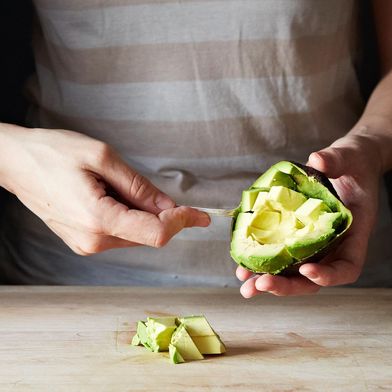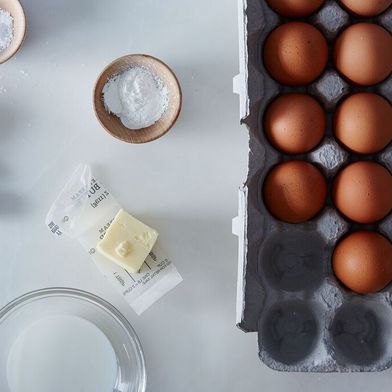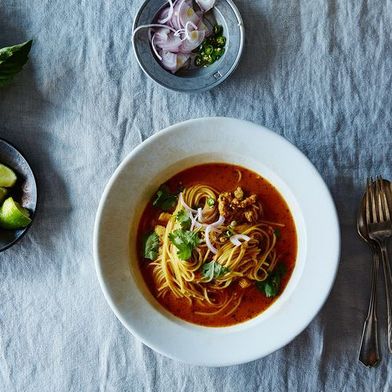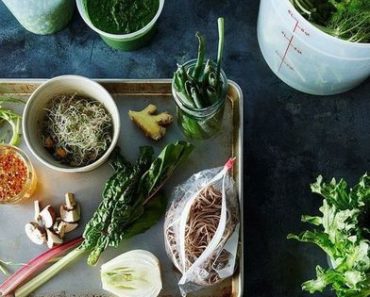Think about your freezer. Is it the resting place of half-eaten ice cream containers? Or most-likely expired pizza? Have you given up on food and stuffed jeans or sweaters in your coldest drawers? Look, your freezer doesn’t have to be a dark, cold, scary place. Well, it should be dark and cold… but not scary!

In fact, you probably know more about that chilly chest than you think, say self-proclaimed “freezer cooking evangelists,” and authors of From Freezer to Table, Rachel Tiemeyer and Polly Conner. After years of sharing freezer-friendly menus and cooking party tips at The Thriving Home blog, the two Missouri-based cooks have learned the ins and outs of freezer storing and thawing.
Want to see where you lie on the freezer savvy spectrum? Try this quiz from Tiemeyer and Connor. (Psst—if you need a refresher, check our our handy guide!)
1. Most frozen food can remain safely frozen for:
- 3 months
- 12 months
- Like, forever!
- I have no clue.
2. Which of the following food items do NOT freeze safely?
- Eggs in shell
- Tomatoes
- Canned food (still in cans)
- Mayonnaise
by Caroline Lange

by Sarah Jampel
3. Freezing homemade meals destroys:
- All bacteria and parasites that might be in the food
- Nutrients in the food
- Everything I like about good food
- None of the above
4. According to food safety experts, what temperature should your freezer register at all times to keep food safe?
- 32°F
- 15°F
- 0°F
- Any of the above will freeze food safely
5. True or False? It is safe to freeze meat or poultry directly in its original store packaging.
6. In 15 seconds, can you name three safe methods for thawing frozen food?
7. True or False? Once a food has been frozen and thawed, you should not freeze it again.

by Ali Slagle

by Klancy
8. The coldest spot in the freezer is:
- Right next to the vent where the cold air comes out.
- Since cold air sinks, it’s the bottom shelf of any freezer.
- The ice box. It’s filled with ice.
- The rear center. It’s the most insulated point.
9. What is the ideal number of participants at a freezer cooking party or in a freezer club?
- 12+ (The more the merrier!)
- 8
- 6
- 2 (I’m an introvert. Please let this be the right answer!)
Answers
1. C. Like, forever!
The USDA guidelines state, “Food stored constantly at 0°F will always be safe. Only the quality suffers with lengthy freezer storage.” Pretty great, right?
2. A. Eggs in shell and C. Canned food.
You can freeze almost any food safely, with the exception of these two. While mayonnaise does not freeze and thaw well (the texture gets funky), it is safe to freeze it. Tomatoes do fine in the freezer either raw or blanched first, but they are best used in soups, stews, or a sauce later. Some other ingredients that can change texture as they thaw: celery, potatoes, citrus fruits, sour cream, fried food, and pasta cooked beyond al dente.

by Alice Medrich

by Rebecca
3. D. None of the above!
- The USDA site says, “Freezing to 0°F inactivates any microbes—bacteria, yeasts, and molds—present in food. Once thawed, however, these microbes can again become active, multiplying under the right conditions to levels that can lead to foodborne illnesses.” Basically, handle all frozen foods just as you would fresh food and cook them thoroughly. For a good guide on safe minimum internal temperatures various foods should reach will cooking, check the USDA.
- There is little change in nutrient value during freezer storage.
4. C. 0°F.
Many freezers are mistakenly kept too warm. Track the temperature in your freezer with an inexpensive refrigerator/freezer thermometer.
5. True. Sort of.
This is a little tricky. While it is safe to freeze items in their original packaging, we wouldn’t recommend it. That’s because most of the time that kind of packaging is permeable to air, which can make your meat taste like lightly roasted cardboard. However, you can freeze unopened vacuum-sealed foods. No air is getting into those bad boys.
6. (1) In the refrigerator, (2) in cold water, and (3) in the microwave.
Raw or cooked meat, poultry, or egg products must be kept at a safe temperature during “the big thaw,” according to the USDA. As soon as they become warmer than 40°F, bacteria that may have been present before freezing can begin to multiply. The most effective and safest way to thaw a freezer meal is to put it in the refrigerator for 24 to 48 hours. The exact thawing time will depend on the size of the meal. Another safe thawing option is to place the food in a leak-proof plastic bag and immerse it in cold water, changing the water every 30 minutes. This still takes a bit of time, but it’s quicker than the refrigerator option. The fastest option is to microwave-defrost food in a microwave-safe dish, according to your microwave’s instructions. It can dry out food a bit.
7. False.
If the food is safely thawed in the refrigerator, it is safe to refreeze it without cooking. However, the texture and color may be compromised upon refreezing and thawing.

by Jaime Brockway
8. D. The rear center.
9. C. Six.
We’ve found that if you have more than six participants, it’s “too many cooks in the kitchen.” Fewer than six, and you’ll have a hard time stocking your freezer.
So, how many did you get right? Any surprises? Let us know in the comments!
(via Food52)






